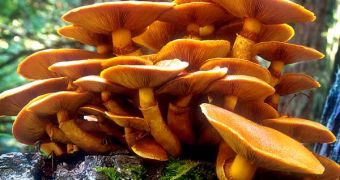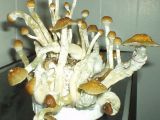The "magic mushrooms" are gilled fungi that induce psychotic effects due to the alkaloid called psilocybin.
Psilocybin occurs in high levels in some species of Psilocybe and Panaeolus, and in lower levels in Conocybe, Gymnopilus and Inocybe. Psilocybe, Panaeolus, Conocybe grow in varied habitats, from dung to humus. Inocybe are mycorrhizal (from symbiosis with the trees' roots) while Gymnopilus grow on wood.
The spores of these mushrooms are completely free of psilocybin. The total potency varies greatly between species and even between specimens of one species in the same batch.
Younger mushrooms contain relatively more alkaloids and have a milder taste than larger, mature mushrooms. Mature mycelium contains some quantity of psilocybin, which can be extracted with an acidic solution, but young mycelium (recently germinated from spores) does not.
Many types of psilocybin mushrooms turn blue when handled or damaged, but this is not a precise method of determining a mushroom's toxicity. Psilocybin is rapidly turned by the body to psilocin which mimics in brain the serotonin. The psilocybin is mildly toxic, 1.5 times more than the caffeine and death from psilocybin intake alone is unknown. The psilocybin content of mushrooms depends on species, growth and drying conditions, mushroom size, and is on average roughly 5mg/g of dried mushroom, or 1mg/2g of fresh mushroom. Psilocybin is absorbed in the mouth and stomach and its effects start in 10-60 minutes after ingestion, persisting 2-6 hours depending on dose, species and individual metabolism. A standard dose is from 10-50mg Psilocybin, approximately 1-5g dried mushroom or 10-50g wet mushrooms. The effects of psilocybin are often pleasant, even ecstatic, including a deep sense of connection to others, confusion, hilarity and a general feeling of connection to nature and the universe.
Difficult trips may occur when the mushrooms are taken in an improper environment, by an inexperienced person, or in a high dose. At low doses, hallucinatory effects occur, including walls that seem to breathe, a vivid enhancement of colors and the animation of organic shapes. At higher doses, experiences tend to be less social and boosting even more intense spiritual ones.
Mental and physical tolerance to psilocybin builds and dissipates quickly.
Taking psilocybin more than three or four times weekly (especially two days in a row) can have diminished effects. Tolerance dissipates after a few days, so frequent users often keep doses spaced five to seven days apart to avoid the effect. Still, the consumption of psilocybin may cause Hallucinogen Persisting Perception Disorder (HPPD).
Psilocybin can also induce small physical effects, like appetite loss. Overdoses (above 2? grams) induce feelings of coldness, numbness of the mouth and adjacent features, nausea, weakness in the limbs (making locomotion difficult), excessive yawning which usually occurs during the come-up, swollen features, pupil dilation and stiffness in points of the body and consumers can take weird positions as they lose ability to accurately assess the flow of time and their level of fatigue.
In most countries, the possession and use of psilocybin mushrooms is prohibited under almost all circumstances and often carry severe legal penalties.
Because of the ease of cultivating psilocybin mushrooms or gathering wild species, psilocybin itself is nonexistent on the illegal drug market. Many psilocybin mushrooms have a bitter taste that prevents people from their consumption.
Gymnopilus luteofolius from the Pacific Northwest of North America contains psilocybin but it is unpalatable due to the bitter taste, while Gymnopilus spectabilis is marketed in Japan as "warai take", "the mushroom that makes you laugh a lot".

 14 DAY TRIAL //
14 DAY TRIAL // 
